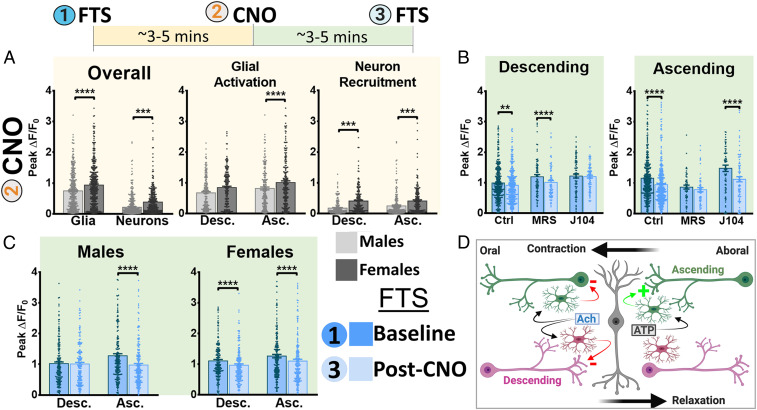Fig. 5.
Reciprocal modulation of enteric glial and neuronal activity varies with ENS circuitry. (A, Top Inset) Myenteric ganglia were stimulated with either ascending or descending FTS before and after CNO application. (Bottom Left) Unpaired CNO-induced effects on glial activation and neuronal recruitment in male and female mice. CNO provokes a more robust Ca2+ response in female glia compared with male glia. Similarly, the magnitude of the neuronal Ca2+ response evoked by CNO-induced glial activation is greater in females than in males. (Bottom Middle and Bottom Right) Glial and neuronal CNO responses are further substratified according to circuit pathway. In females but not males, glia associated with the ascending pathway are more robustly activated by CNO. For females, neuronal recruitment by CNO is categorically more robust in both ascending and descending pathways. (B) Paired neuronal Ca2+ responses evoked by descending and ascending pathway activation prior to and following CNO treatment. Under control conditions, glial stimulation with CNO attenuates neuronal responses in both pathways. The CNO-induced reduction in neuronal recruitment is more pronounced in the ascending pathway than in the descending pathway. (Left) Pretreatment with the M3 cholinergic antagonist, J104129, abolishes this effect in the descending pathway. (Right) Pretreatment with the selective P2Y1 antagonist, MRS2179, preferentially blocks CNO-induced reductions in neuronal responses in the ascending pathway. (C) Substratifying the effects of CNO on neuronal pathway responses reveals a sex dependence in the effect of glial activation on neuronal responses. (Left) In males, glial activation with CNO attenuates the neuronal Ca2+ response in the ascending circuitry without affecting descending pathway responses. (Right) In females, glial activation by CNO attenuates neuronal responses in both network pathways. (D) Mechanistic paradigm highlighting pathway-specific roles of glial purinergic and cholinergic signaling. Neuronal recruitment within the descending circuitry is subject to glial inhibitory control in an M3-dependent manner. As such, a cholinergic blockade with J104129 unleashes neuronal recruitment by descending synaptic stimuli. Neurons formerly recruited by the ascending circuitry are subsequently activated by both pathways (see increase in baseline response in B, Left. In contrast, glial purinergic signaling preferentially bolsters neuronal responses within the ascending circuitry. Abrogating P2Y1 activation with MRS2179 uncouples neurons from this pathway (see decrease in baseline response in B, Right, allowing for unopposed activation by the descending circuitry). These effects are concordant with alterations in population recruitment dynamics described in Fig. 3G.

